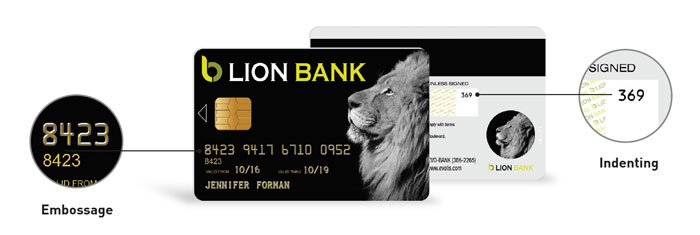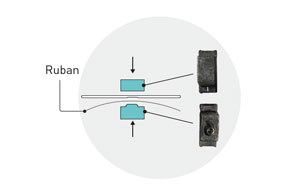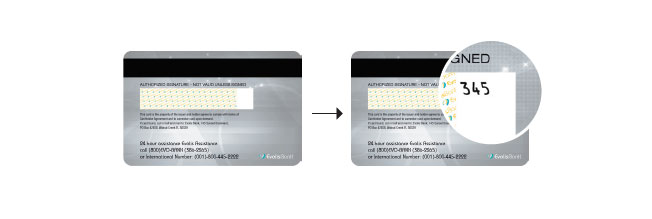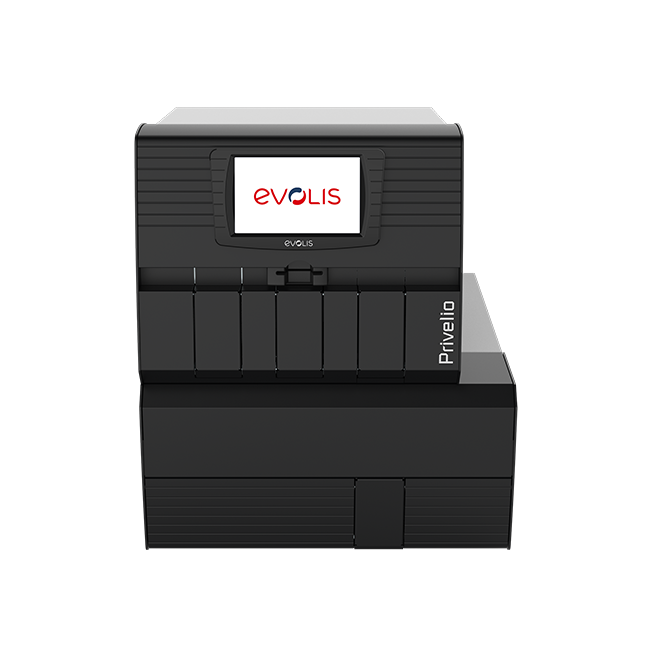Embossing & indenting
Embossing and Indenting for the Printing of Financial Cards
Embossing and indenting allow to increase the security level of financial cards. Indeed, these methods are very effective against fraudulent alteration of the personalyzed data.
These technologies can be applied to the variable text elements of the cards:
- account number
- cardholder name,
- expiration date,
- cryptogram on the back of the card.

How does embossing work?

Embossing, also known as stamping, is a technique that consists of molding material mechanically and without heat, through the pressure of a raised die on a recessed die. This method produces a permanent relief on the surface of the card and increases its level of security.
Although it is possible to emboss characters anywhere on the card, it is usual for cards to be embossed in the bottom half of the card, and in accordance with ISO/IEC 7811-1: 2014 – Identification cards — Recording technique — Part 1: Embossing. This helps to ensure the embossing will not compromise any signature panel and or magnetic stripe on the back of the card.
Cards can only be embossed on one side.
How does indenting work?

Indenting is a technique that consists of molding material mechanically and without heat, through the pressure of a raised die on a flat die. This method produces a permanent indent on the surface of the card, like an engraving.
The characters thus engraved are then printed thanks to a ribbon, in black or white. This technique increases the security level of the bank card.
Visual cryptograms are encrypted codes printed on credit cards. This is to ensure that an actual card exists for the card number provided by an individual in a remote transaction (e.g. purchases made online) to prevent fraudulent or unauthorized utilization.
The visual cryptogram can be personalized on the back of the card, in black or white, thanks to the indenting technology.

For the personalization of cardholder data, the indenting can also be done on the front of the card.
Embossing and Indenting with Privelio XT

The Evolis Privelio XT printing system uses embossing and indenting processes to personalize financial cards. Privelio XT personalizes blank or preprinted credit cards in color sublimation and monochrome thermal transfer, directly within the bank branches. The system is able to manage different card designs.
With Privelio XT, financial institutions have a flexible solution that allows them to produce cards on site, on demand. Furthermore, banks that issue most of their cards using embossing and indenting processes in a centralized model can obtain the same finish for their cards instantly issued in branches.
Embossing cards with Privelio XT is a 2-step process:
- Printing characters to be embossed through monochrome thermal transfer or color sublimation.
- Embossing characters already printed on the card.
The standard Privelio indenting module personalizes characters on the back of the card, in black or white. Ribbons offer high capacities (up to 1,500 cards for 7 characters per card). By ordering optional sets of characters, Privelio XT can also apply the indenting technology on the front of the card.


